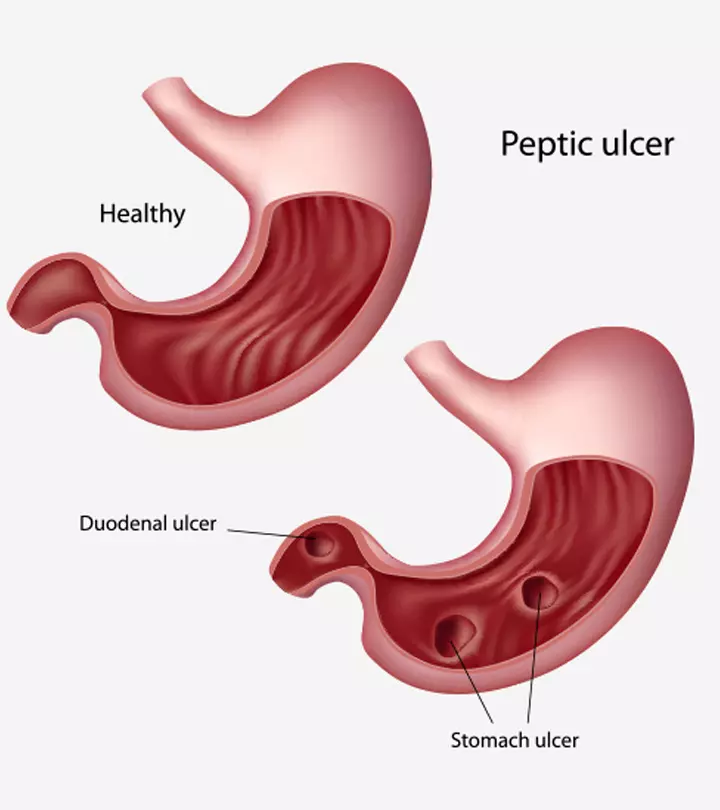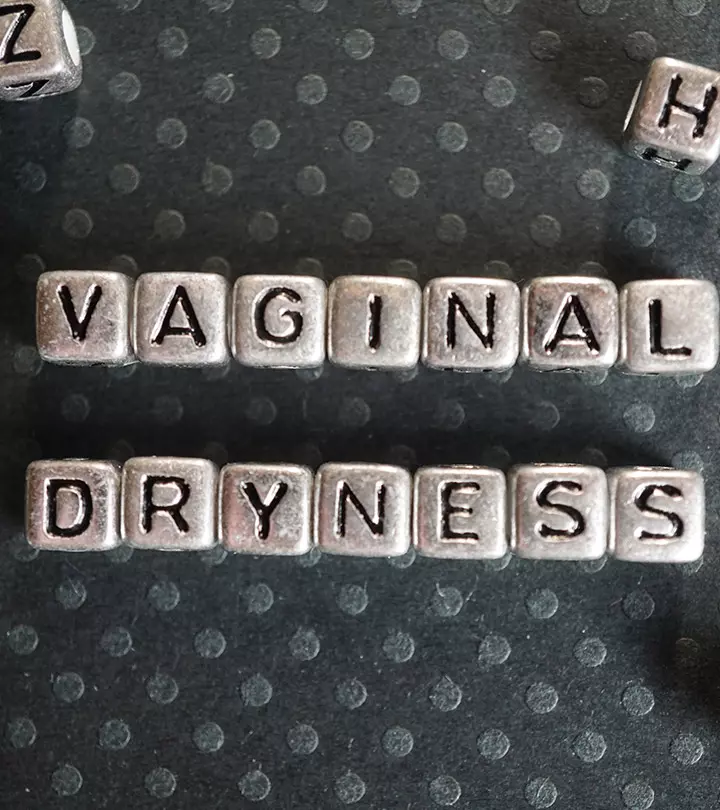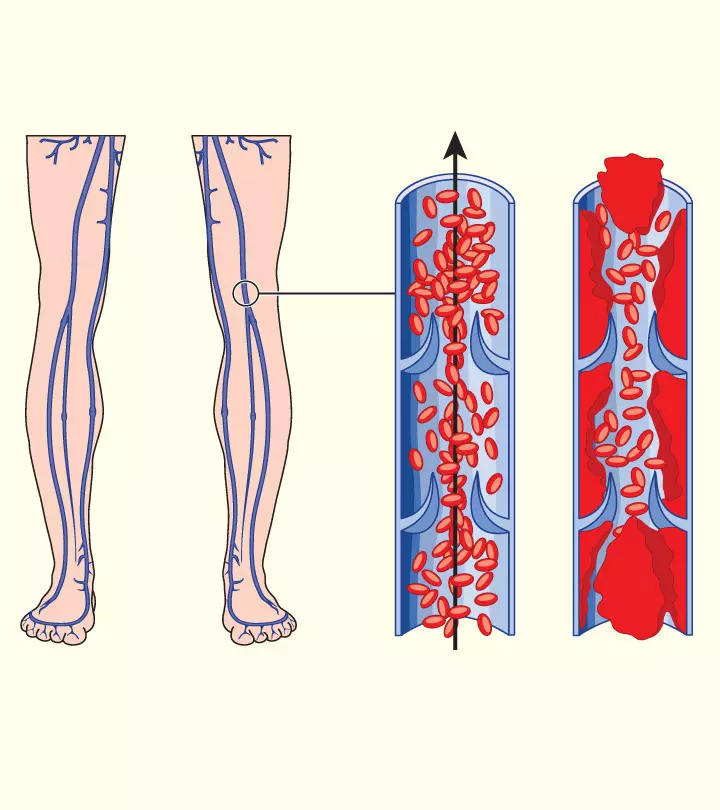
Image: Shutterstock
Even before they start eating solid foods, you may notice your baby gagging. While gagging, food or an object is pushed back from the throat into the mouth. It is a highly sensitive reaction frequently elicited in young infants to prevent choking. However, it gets less sensitive with age (1). Although it is a protective response, it can cause feeding and drinking problems in babies and may lead to nutritional inadequacies if gagging occurs frequently. In addition, frequent gagging in babies older than 4–6 months can indicate underlying medical conditions or improper feeding techniques (1). Therefore, if your baby gags frequently, you should see a pediatrician. This article discusses the cause of gagging, preventative strategies for frequent gagging, and how to distinguish between choking and gagging in babies. Parents and caregivers should understand these aspects to ensure safety and build confidence in managing feeding challenges.

Key Pointers
- Gagging, or gag-reflex, is important as it prevents babies from choking on hazardous food or objects.
- Occasional gagging is normal in newborns.
- Bluish discoloration of the lips, inability to make noise, etc., are some signs of choking.
Is Gagging Good For Babies?
Gagging or gag-reflex plays an essential role in protecting your little one who is learning eating and drinking skills. Gagging protects from choking, which means most babies gag on foods that they are not able to chew or swallow. When gagging occurs, the muscles at the back of the throat contract to prevent the airway from being obstructed. This reflex helps propel food back into the mouth and halts the swallowing process (2).
If a baby is unable to gag food or any foreign bodies kept in their mouth, it could slide down to their throat and reach the airways. Aspiration of food to the lungs can result in aspiration pneumonia (3). A piece of food or toy could be life-threatening if it leads to airway obstruction.
Additionally, beyond its role in preventing choking during feeding, the presence or absence of the gag reflex is also a significant indicator in neurological assessments, particularly when evaluating brainstem function (4).
When And Why Do Babies Gag?
When you start feeding solids around 6 months, your child’s gag reflex is positioned farther forward in the mouth. As they grow, it gradually moves back into the throat. Because of this, coughing, gagging, and expelling food are common during the early months of introducing solids (5). Occasional gagging is normal in young babies. This helps infants throw up the pieces of food that are big to swallow. Faster milk supply and overfeeding or being too full may also cause young infants to gag during bottle-feeding or breastfeeding.
Your little one is most likely to gag in the following situations.
- While breastfeeding
Gagging on breast milk can be due to an overactive letdown of milk (6). Getting help from a board-certified lactation consultant can be useful to manage breastfeeding difficulties.
- While bottle-feeding
Incorrectly sized bottle nipples can be a significant reason for gagging while bottle-feeding. The texture of bottle nipples varies, and often oversized bottle nipples can stimulate gag reflex in babies. Larger holes in the feeding bottle may also cause gagging due to more food coming into the mouth, making it difficult to swallow at a time (6).
 Did you know?
Did you know?- Teethers and mouthing toys

Chewing on various toys and teethers can often cause a gag reflex in some babies. Gagging may often happen in the initial days of mouthing in babies. You may notice the sensitive gag reflex disappears over time. An overproduction of saliva when babies undergo teething can also cause babies to gag (8).
- Solid foods
Most infants may have an occasional gag on solid foods (9). Eating is a skill that develops over time, and it takes time to coordinate chewing and swallowing. The thick texture of food can be a reason for gagging in babies since it is difficult for them to chew and swallow. However, pureed baby food may also cause occasional gagging due to poor eating skills.
Is It Normal For Babies To Gag Frequently?

Frequent gagging may not be normal in most cases. Excessive gagging can be due to the following reasons (10).
- Lack of coordination of oral motor skills. The coordinated movement of tongue and jaws to chew and swallow is known as oral-motor or oromotor skills. Babies could gag while eating due to poorly developed oromotor skills. Most babies learn eating skills as part of their development or as you gradually teach your baby to chew food. Babies with neurological disorders and structural abnormalities may fail to reach this developmental milestone and often require additional interventions and training.
- Sensory issues with food may also cause gagging. Babies who experience gagging due to oral-sensory issues usually begin to gag while consuming foods with a specific texture.
- Improper feeding positions and techniques may also cause gagging in babies.
- The hard or thick texture of food, overfeeding, or feeding more quantity per bite or spoon could also make your little one gag since they are unable to chew and swallow.
- Frequent gagging may also be observed if your baby has a hypersensitive gag reflex (HGR). Babies with a strong gag reflex may struggle with thick or sticky foods that are harder to swallow. Foods like mashed potatoes and bananas can get stuck in their mouth, making them gag more often (4).
- Frequent gagging happen when a child is overwhelmed by a full mouth of food or feels like they are losing control during mealtime, especially if they are being pressured to eat. Some children gag as a way to avoid certain foods, especially if they are unfamiliar with the texture (11).
- Gagging can also be an emotional reaction. If mealtimes are stressful or if a child has had negative experiences with eating. In some cases, gagging becomes a learned behavior. A child might do it to express dislike for a food or to get extra attention from caregivers (11).
Note:
Baby gagging does not depend on the presence or absence of teeth. It is a common belief that babies require teeth to eat, but they can eat using their strong gums.
Is Your Baby Gagging Or Choking?
Gagging and choking are not the same. Gagging is a protective reflex that prevents a baby from choking, whereas choking can be life-threatening if left unattended. Gagging is common and normal while your baby learns to feed themselves. It is essential to differentiate between gagging and choking in babies since choking requires immediate attention (5).
Gagging can happen when babies have something or even nothing in their mouths. Just like adults, babies and toddlers may also gag when they see the food they dislike, or when they eat something new and unfamiliar. In contrast, choking means something is already in the upper airways, and the baby cannot get that out. Knowing the difference between gagging and choking is important for a quick and appropriate response. Find below the differences between gagging and choking (12):
Gagging vs. choking
| Gagging | Choking |
|---|---|
| The face may look bright red and open mouth with tongue thrust forward. | The lips may turn blue. |
| Splutter or cough can be seen as they clear the food. | Silent, often unable to make noise. |
| Babies have a hyper gag reflex to protect themselves from choking. | Choking is accidental, and it is not a protective reflex. |
| Do not interfere while gagging, they can manage Interfering may cause choking. | Do first aid to dislodge the food or any obstructive material from the airways. |
Note (12):
- If your baby is red and loud, they may be gagging; let them work to clear it.
- If your baby is blue and silent, they may be choking, and they need your help. If the foreign body is not dislodged from the airway, seek emergency medical assistance.
 Point to consider
Point to considerAn infant who is choking may not be able to breathe or produce sound. They need first aid, such as back blows or chest thrusts, to remove food stuck in the airway (13). If the baby loses consciousness, you should stop back blows or chest thrusts and call 911 immediately.
Based on the statistics from the US Centers for Disease Control and Prevention (CDC) study cited by the American Academy of Pediatrics (AAP) policy statement “Prevention of Choking Among Children” (2025), the graph below illustrates the occurrence of fatal choking in young children. The data reveals that 65% of children aged 35 months and under experience fatal choking accidents.

Incidence of fatal choking in young children
Source: Childhood choking: An overview; Texas Health and Human Services/CDC/AAPThus, learning about first aids for choking in infants and CPR techniques can be helpful for parents. Knowing how to identify and handle emergencies could help parents and caregivers act immediately.
What Should You Do When Your Baby Gags?

If you are sure that your baby is gagging, do not do anything, and remain calm. Let your baby gag and throw up the food that they are unable to swallow. Interrupting while gagging may result in choking, so let your little one use their protective reflex.
You may help them lean forward if there is continuous gagging. This could help them bring the food from the back of their mouth to the tongue and spit it out. You can also stick your tongue out and ask your baby to imitate the same (2). If the baby is gagging and unable to push food out, you may use your little finger to sweep out the food from their tongue.
Letting them relax before resuming feeding could be ideal.
When Should You Worry?

Frequent gagging should be mentioned to the pediatrician on the next visit. Doctors can diagnose the causes of constant gagging.
If your baby has frequent gag interfering with their food and water intake, seek a pediatrician’s evaluation. Early identification of feeding problems and feeding therapy initiation could prevent growth restrictions due to lack of nutrition. Early feeding therapy may also have more favorable outcomes than delayed approaches.
How To Prevent Gagging In Babies?

Although gagging is a protective reflex, frequent gagging could interfere with feeding and may lead to nutritional deficiencies and growth delays. Moreover, the feeding method or type of foods that causes gagging could also increase the risk of choking in babies.
You may try the following tips to prevent gagging while feeding (6).
- Let your baby feel relaxed before feeding.
- Maintain a calm atmosphere free from distractions during meals to help the baby focus on eating.
- Choose the right feeding bottle. Seek expert help to choose the bottle size, nipple length, and the bottle hole size appropriate for your baby’s age and feeding skills.
- Nursing in positions where the baby’s head is higher than the breast, such as a laid-back or diagonal cradle hold, can help manage milk flow and reduce gagging.
- Feeding every 2–3 hours helps maintain milk supply and prevents engorgement, which can lead to a forceful let-down.
- Gradually introduce solids, starting with purees and moving to solid foods as your baby adjusts.
- Never force them to eat more than they need or desire.
- Ensure your baby is able to sit upright on the feeding table before starting a solid diet. Most babies can be weaned around six months of age.
- Use a feeding table to keep your baby in an upright position while eating.
- Do not encourage feeding solids in a laid-down position or while playing.
- Babies may not be able to swallow a lot of food. Give a small amount of food on a spoon to the front of the baby’s tongue rather than a spoonful of food to their mouth. This method lets your baby suck the spoon for food without stimulating their gag reflex.
- Once your baby is ready to eat table food other than purees, you may cut their food into small bite-size pieces.
- Avoid foods, such as nuts, popcorn, and whole grapes, that can be a choking hazard.
If your baby has frequent gagging on pureed soft foods, while bottle-feeding, or while breastfeeding, seek medical care to identify the underlying causes.
You may look for oversupply or too fast let down of breast milk if your baby is frequently gagging or choking while breastfeeding.
Is Gagging A Sign Of Gastroesophageal Reflux Disease?
Gastroesophageal reflux disease (GERD) or acid reflux can be a reason for gagging in some babies. Infants younger than three months may spit up or vomit (also called posseting) a few times a day due to an immature digestive system. However, it does not cause any problems, and the baby usually outgrows it within a year (14) (15). When normal gastroesophageal reflux (GER) or spitting up becomes severe or chronic, then it may indicate GERD. When a baby has reflux, issues such as newborn gagging in sleep are also common.
You may notice other signs of acid reflux, such as abdominal discomfort or frequent coughing, along with gagging if GERD causes it. Acid reflux may often result in frequent gagging, and you may seek medical care for an exact diagnosis.
Frequently Asked Questions
1. Does gagging lead to choking?
The gag reflex prevents choking by stopping the food or any object from entering the windpipe. But if you try to manually take the food out of the mouth while gagging, it may further push it down and result in choking (16).
2. What does a baby’s gagging sound like?
Gagging produces loud noises by causing one to cough, gurgle, and sputter while spitting up (16).
3. Can a tongue tie cause a baby to gag?
Yes, a tongue tie in babies may trigger a gagging reflex, which might cause them to gag, even when you feed them slowly (17).
4. Can teething cause a baby to gag?
Some babies may gag during their teething phase, due to excessive saliva production (8).
It can be tough for parents or caregivers to watch a baby gagging on food or breastmilk so, they tend to have an emergency response to the situation. However, it is a protective mechanism to prevent choking. Babies may gag more during the initial weeks of solid food and gradually learn to eat. Through gagging, they clear their throat, preventing food from entering the airways. It is important to differentiate between gagging and choking in babies since choking requires immediate help. Lips may turn blue and not make noises while chilling, and you may dislodge food from their throat using various methods.
Infographic: Effects Of Certain Conditions On Gagging
Gagging is a protective reflex in babies, which starts diminishing by six months. However, sometimes, you may notice that your baby either gags frequently or has a reduced gag reflex. If necessary, you may talk to your doctor about it and seek medical attention. This infographic highlights some conditions that affect gagging in babies.
Some thing wrong with infographic shortcode. please verify shortcode syntax
Illustration: Baby Gagging: Reasons Prevention And When To Worry

Image: Dall·E/MomJunction Design Team
In this video, you will learn about babies gagging on food and understand why it’s actually a good thing. Know how their bodies are learning to protect them from choking.
References
- Oral Reflexes and Feeding.
https://sensorysolutions.org/home/blog/oral-reflexes-and-feeding/ - Gagging Choking What Parents of Babies Should Know.
https://www.lancastergeneralhealth.org/health-hub-home/motherhood/the-first-year/gagging–choking-what-parents-of-babies-should-know - Aspiration Pneumonia.
https://www.ncbi.nlm.nih.gov/books/NBK470459/#:~:text=Aspiration%20pneumonia%20occurs%20when%20oral,swallowing%20or%20protective%20airway%20reflexes. - Physiology, Gag Reflex.
https://www.ncbi.nlm.nih.gov/books/NBK554502/ - Choking vs. gagging: What parents need to know when introducing solid foods to children.
https://childrenswi.org/at-every-turn/stories/choking-vs-gagging-what-parents-need-to-know-when-introducing-solid-foods-to-children - Breastfeeding FAQs: Spitting Up, Gagging, and Biting.
https://kidshealth.org/en/parents/breastfeed-spitting-up.html - Starting Solid Foods.
https://www.healthychildren.org/English/ages-stages/baby/feeding-nutrition/Pages/Starting-Solid-Foods.aspx - Your Infant is Teething: Know the Signs and Symptoms.
https://www.chla.org/blog/advice-experts/your-infant-teething-know-signs-and-symptoms - Joan C Arvedson; (2025); Complementary feeding in the first year of life: choking and gagging; what about nutrition?
https://pmc.ncbi.nlm.nih.gov/articles/PMC10594011/ - What are oral-motor and oral-sensory problems?
https://childrenswi.org/medical-care/gastroenterology-liver-and-nutrition-program/conditions/oral-motor-and-oral-sensory-problems - Gagging, Choking, and Spitting.
https://www.rch.org.au/uploadedFiles/Main/Content/speech/200101%20FandE%20Gagging%20Choking%20A4%20FSheet_FA_WEB.pdf - Choking and gagging on food.
https://www.nhs.uk/start-for-life/baby/weaning/safe-weaning/choking-and-gagging-on-food/ - Signs a baby is choking.
https://www.redcross.org.uk/first-aid/learn-first-aid-for-babies-and-children/choking-baby - GERD (Gastroesophageal Reflux Disease) in Children.
https://www.stanfordchildrens.org/en/topic/default?id=gerd-gastroesophageal-reflux-disease-in-children-90-P01994 - What is baby reflux? Symptoms and support.
https://www.nct.org.uk/information/baby-toddler/baby-and-toddler-health/what-baby-reflux-symptoms-and-support - What’s The Difference Between Baby Gagging And Choking? (Plus, How To Safely Introduce Peanut).
https://www.preventallergies.org/blog/baby-gagging-vs-choking - Tongue-tie in babies.
https://www.nct.org.uk/information/baby-toddler/feeding-your-baby-or-toddler/tongue-tie-babies#:~:text=A%20tongue%2Dtie%20can%20make
Community Experiences
Join the conversation and become a part of our nurturing community! Share your stories, experiences, and insights to connect with fellow parents.
Read full bio of Pranjul Tandon
Read full bio of Dr Bisny T. Joseph
Read full bio of Rohit Garoo
Read full bio of Shinta Liz Sunny

















